For several months now, Kōhei Horikoshi’s “My Hero Academia” has appeared to be on the cusp of finishing its current story arc. This prolonged ending has come as a result of the serious threat posed by Overhaul, the young leader of the Shie Hassaikai, to the success of the heroes’ joint venture. After all, while the young girl Eri was initially pried away from the clutches of Overhaul and Chronostasis some time ago, the youthful Yakuza head was unwilling to accept defeat. His rage over the situation escalated, and so with it his desperation and drive to emerge victorious at any cost, but as of the end of last month’s chapters, it appeared as if Deku had finally bested Overhaul.
The first of this month’s batch indeed confirmed this victory for the heroes, in that they managed to take down Overhaul, the Hassaikai, and retrieve Eri. But rather than leave things there, mangaka Horikoshi establishes that actions in the world of “My Hero Academia” have consequences. He then goes one step further, to demonstrate that this is the case with both the heroes’ rescue efforts as might be expected, but also with Overhaul’s prior interaction and treatment of Tomura Shigaraki and his League of Villains. In its entirety, this month’s chapters has served as a fantastic conclusion and wrap-up to the significant time the series has spent with the Shie Hassaikai, and in addition, a captivating teaser of what could be to come.
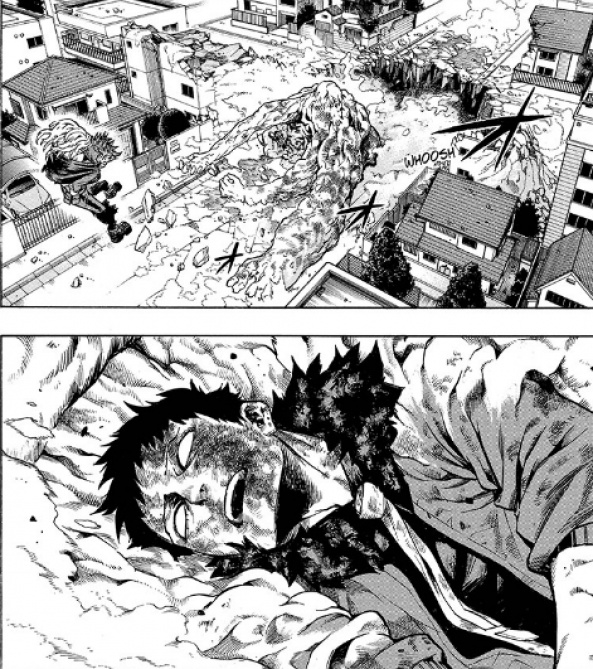
Starting with Chapter 159 though, titled ‘It’s Over!!’, we see a satisfying end to the raid of the Hassaikai base as a whole. Firstly, Suneater and the police rescue Eraserhead, whose use of a swordfish arm, to exploit Chronostasis’s quirk activation condition, was an enjoyable call-back to a line uttered by Fatgum at the beginning of the arc. Secondly, Overhaul is subdued by a combination of Deku, Eri and Uravity. Third and finally, Eraserhead follows through on the promise he made to Deku prior to the raid, in that he would watch over him, by deactivating Eri’s rapidly escalating Rewind quirk. Before moving on to Horikoshi’s welcomingly extensive and well-depicted consequences of the arc though, I’d quickly like to note Deku’s actions following Eraserhead’s forced deactivation of her dangerous quirk. As mentioned in last month’s instalment, Deku has shown his capabilities as a hero this arc, through both his actions and his words. Chapter 159 demonstrates this reality once more, as despite his immense fatigue, he makes sure to catch Eri’s head as she passes out, before it can hit the ground. In this way Deku proves that although people can make heroic statements that are grandiose, such as defeating a monstrous Overhaul in broad daylight, people can also be heroes through the tiniest of actions.
Following the fight’s conclusion, we are given a montage that shows the heroes rendezvousing outside, the other members of the Hassaikai being apprehended, and then a brief conversation between Nighteye and Deku. This is supplemented by a gratifying graphic that declares the rescue of Eri is complete, and doing so was actually achieved in under an hour. One thing I’d like to commend Horikoshi on, now that the arc has wrapped up, is his management of time during the whole affair. At numerous points he has signposted the passage of time, which given the multiple perspectives and splintering of the primary hero group, is something that could have fallen by the wayside. Nevertheless, Horikoshi made sure to communicate this factor well, and this certainly heightens the sense of realism and tension felt when following along with the enthralling action.

The final page of Chapter 159 though works perfectly as a teaser for the chapter to follow, as the emphasis switches from Deku and the heroes, to Shigaraki and his League. As I have mentioned in previous instalments, Horikoshi is certainly becoming less constricted by the heroic focus of the story. As time has passed, he has inserted a number of chapters and story segments that instead revolve around the villains, and Chapter 160, titled ‘Expressway’, is perhaps the best example of that thus far. The villain chapters certainly take on a darker tone, and yet Horikoshi executes this just as effectively as he does the lighter and more triumphant moments spent with the heroes, and in particular Class 1-A.
Continued belowIn this chapter, we see the League of Villains finally make their move. They comprehensively overwhelm a police convoy, accompanied by the Sand Hero Snatch, and concurrently reap their long-awaited revenge against Overhaul. Given the League’s position as an underdog group of outcasts, very much mirrored by Deku’s own position as an underdog hero-in-training, one can’t help but almost root for the villainous yet plucky upstarts. I have previously praised Horikoshi for the development he has given the League of Villains as a group, and its individual members on top of that, and this chapter is no different. Yet while we’ve seen plenty of memorable moments from Toga and Twice in recent months, this chapter very much allows for shine for Shigaraki, Mr. Compress, Dabi, and to an extent, Spinner.
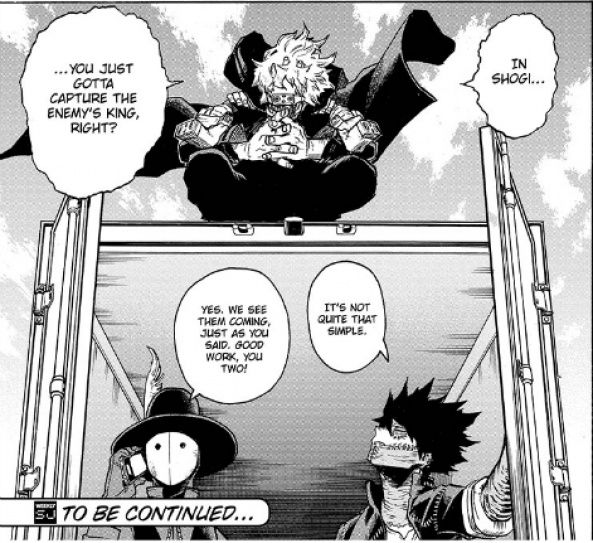
Having been given information by Toga and Twice on the police convey, which is escorting Overhaul and the quirk-destroying bullets, Shigaraki and the League engage with the police on the expressway. The action beats in this chapter are fantastically drawn and choreographed, and manage to highlight the utility of all the League members. That is except for Spinner, whose shaky motives and even shakier driving are played well for comedic effect. I do hope Spinner is fleshed out later at some point, but for now, the attention and further development Horikoshi gives to the other members of Shigaraki’s entourage is sufficiently satisfying.
Mr. Compress in particular shines, as he turns the tables for the villains by de-compressing a boulder underneath a police car, forcing it to flip and lose control, all the while operating with his distinctive showmanship. This then allows Dabi and Mr. Compress to take advantage of Snatch’s heroic nature, as they get behind the pro and compress him into one of Mr. Compress’s signature balls, along with a blast of Dabi’s flames. It is then implied that the hero, given his inability to turn his lower half into sand, is very likely dead. This dialogue instantly sets the tone, for what else is to come in Chapter 160. Another off-hand line of dialogue that caught my attention is the fact that Dabi is beginning to earn a reputation for himself, as a result of numerous burnt corpses. Given the general thought that Dabi’s true identity may be that of a Todoroki, this line leads me to think that this aspect of the story may be building up steam somewhat, and I can’t wait to see the pay-off.
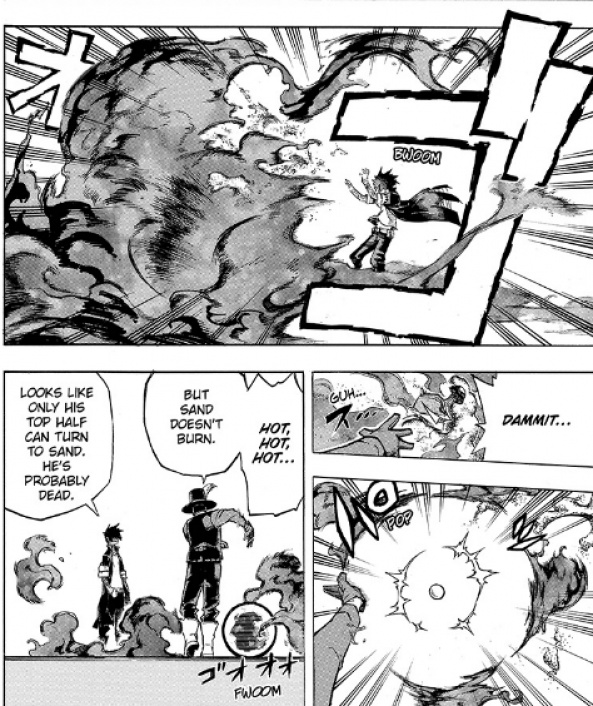
Anyway, Mr. Compress’s focus does not end with Snatch. Alongside Shigaraki, he quickly sees to Overhaul, driven strongly by a need for revenge. After all, the last time the two met, Overhaul destroyed one of Mr Compress’s arms with a single touch. It is therefore poetic justice for Mr Compress to return the favour by destroying one of Overhaul’s arms with a touch of his own, delivered with a grin, a wink, and a display of the prosthetic arm he has now been forced into using. It is truly amazing just how much characterisation and charisma Horikoshi can give a relatively minor character, like Mr. Compress, in a single chapter. In a single scene, Mr. Compress has elevated himself into one of my favourite League members, and I look forward to seeing what Horikoshi elects to do with the villainous entertainer in future arcs.

But the villains, and in particular Shigaraki, aren’t content with simply evening the score. He also believes that killing Overhaul, now he has him at his mercy, isn’t enough punishment either. So Shigaraki decides to mercilessly decay and then remove Overhaul’s other hand, thereby rendering him quirkless, all the while pointing out the irony that the man who sought to remove others’ quirks is now quirkless himself. He proceeds to taunt Overhaul, declaring that he must now watch on helplessly as the League of Villains begins their ascent to the top of the villain hierarchy, utilising Overhaul’s own hard work to do so. While this petulant and vindictive action may be reminiscent of the old Shigaraki, his ability to get the job done, all the while relying on others and maintaining a broader goal in mind, demonstrates the mesmerising growth that the primary antagonist has undergone since his initial introduction.
Continued below
While all of this may appear to depict a suitable conclusion to the arc, and the accompanying intra-villain alliance conflict, Horikoshi is not done there. This, once again, is where Horikoshi sets himself apart from a number of his contemporaries. Alongside this high-octane confrontation and outright victory for the League of Villains, Horikoshi pairs a heart-wrenching emotional climax for the heroes, which cements the arc’s significance and adds a dash of realism to what was undoubtedly a risk-filled operation. While the injuries sustained by Eraserhead, Red Riot, Suneater, Fatgum, Lock Rock and Eri are acknowledged, the true focus is rightly given to the dire situation of Sir Nighteye.
Despite the efforts of the hospital doctors, and even Recovery Girl, Deku and the others are informed that Nighteye won’t make it through the night. Horikoshi manages to illustrate the severity of these injuries in an utterly haunting fashion, as All Might’s former sidekick lies in bed with one arm and one stump, connected to numerous machines through many tubes that occupy the gaping wound in his stomach. Following a brief but important conversation with All Might and Deku, which I will return to very shortly, Lemillion enters the room to see the state of his mentor. What follows is an emotionally charged scene between the two, characters that haven’t been part of the “My Hero Academia” universe for all too long, and still Horikoshi manages to portray a wonderfully gripping yet utterly draining scene, as the pro passes away and the world says goodnight to Nighteye. This though isn’t before Nighteye delivers a warming speech, wherein he utilises his quirk and assures his protégé that despite the loss of his own quirk, he’ll be as fine a hero as any.
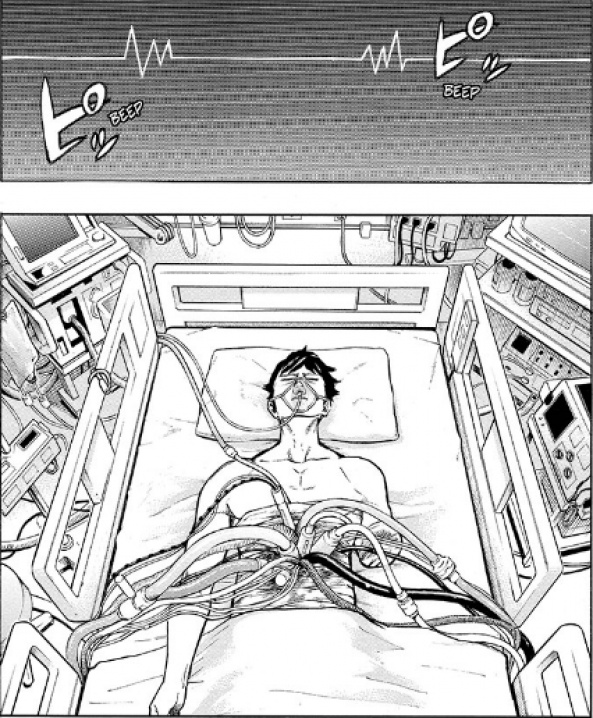
Returning to Nighteye’s conversation with All Might and Deku, this is certainly an important point that Horikoshi needed to touch upon before moving on with the story. Nighteye’s Foresight quirk has been a central element to the narrative over recent months, so the fact that Deku overcame a seemingly unassailable prediction very much required an explanation and thus some closure. Nighteye provided us with this prior to his passing, and it is interesting to note that the natural counter to Nighteye’s foresight is seemingly his own attitude. As opposed to actual foresight, his quirk more accurately resembles hyper-prediction. Yet his negative mentality, representing that of the stereotypical Japanese salaryman who has been conditioned to conform and to not take risks, ensures his visions are indeed self-fulfilling prophecies. But the youthful drive that a number of the heroes involved with this mission had, for obvious reasons, came together to overturn Nighteye’s dour outlook on pre-determined destiny.
As such, this can actually be seen as a very critical look on Japanese culture by Horikoshi, as the Japanese-inspired character of Nighteye, whose past troubles have left him resigned to helplessness, is proved wrong by the new generation. This is especially interesting when that new generation consists of a combination of characters inspired by a European, in Mirio, and the successor of a character rooted in American culture, in Midoriya. This sense of resignation and aversion to risk-taking is a critique often levelled at those who enabled the stagnant Japanese economy, and appears to be creeping into numerous Japanese-led stories in recent times. With this in mind, and the way it was handled, I must again commend Horikoshi for both this arc and this series as a whole, in regard to the complexity, sincerity and entertainment provided through his storytelling.
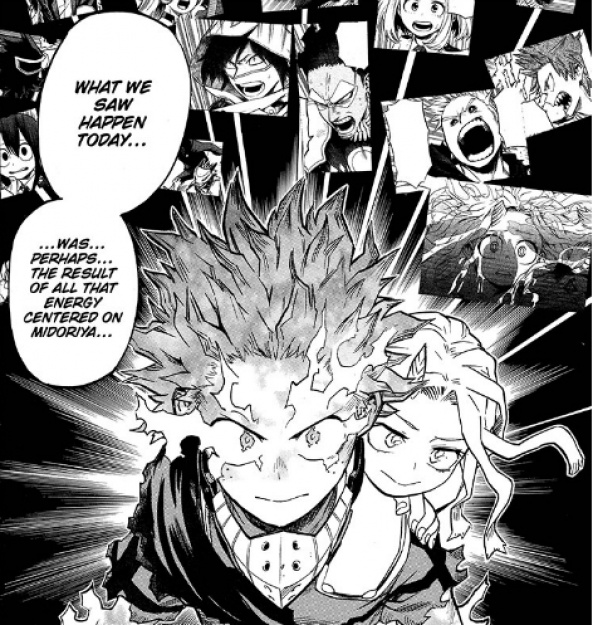
To conclude, much has happened in this month’s chapters, and that’s without really even touching on the shorter Chapter 162, titled ‘Suitable One’. For many months I have waited in anticipation for the climax and fallout of this arc, as Horikoshi has excelled many times before in this manner. And once again, I can safely say that I am not disappointed in the slightest by Horikoshi’s handling of true consequences that result from an arc of serious weight and significance. The death of Nighteye, the growth of Deku, Shigaraki, and their respective comrades, and the monumental change thrust upon Overhaul and Lemillion has been a joy to behold in a story such as this. Alongside the hints of progress being made in the stories of Gran Torino, Tsukauchi, and the new fleshed-out threat of Giganto-Machia, in addition to the re-appearance of Bakugo and Todoroki in their efforts to eventually claim their Provisional License, I can’t wait to see where “My Hero Academia” goes next. I hope you’ll all join me next month, to find out my thoughts on exactly that.






